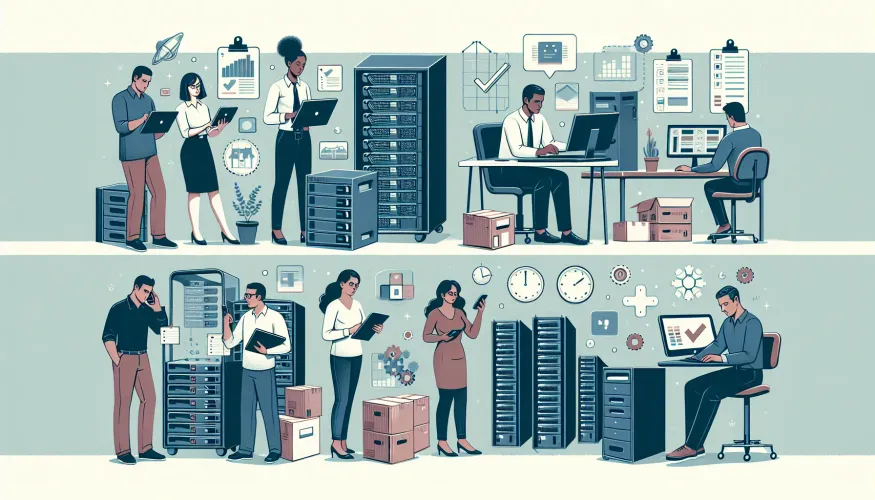Tips for Effective IT Asset Management

In today's technologically advanced world, effective IT asset management has emerged as a top concern for businesses. The systematic process of locating, tracking, and optimizing the value of a company's software and hardware assets is known as IT asset management, or ITM. Organizations may increase security measures, guarantee regulatory compliance, and achieve considerable cost reductions by putting strong ITAM processes into place.
We will examine IT asset management in detail in this blog article, stressing its importance, background, and practical advice for efficient ITAM.
An Overview of IT Asset Management
IT asset management encompasses the lifetime management of hardware and software assets from purchase to disposal and goes beyond just maintaining an inventory of these assets. This reduces expenses and hazards while maximizing an organization's value.
Important ITAM Components
- The discovery of assets
The initial stage in ITAM is accurately identifying all of the organization's IT assets, including network, software, and hardware components.
For instance: A large corporation may utilize network discovery tools to identify all devices connected to their network, ensuring nothing is missed.
- Inventory Management
keeping a thorough record of all IT assets, including user manuals, warranty status, and purchase dates.
For instance: An IT management platform, such as Jira Service Management, may be used by a startup to monitor software licensing and guarantee compliance.
- Management of Lifecycle
coordinating the acquisition, use, upkeep, and disposal of IT assets.
For instance: To maximize efficiency and save expenses, a company may have procedures in place for hardware replacements every four years.
- Optimization
making ensuring that IT resources are used effectively and economically by analyzing and optimizing their utilization.
For instance: identifying and repurposing underused servers through routine audits.
- Adherence to the rules
ensuring compliance with organizational rules, legal obligations, and license agreements.
As an illustration: consider using compliance management software to keep tabs on software licensing and steer clear of steep fines.
The Value of IT Asset Administration
Effective Cost Savings Significant cost reductions are achieved by maximizing current resources and preventing needless purchases with the use of ITAM.
-
Efficiency in Operations Simplified asset management lowers downtime and guarantees timely repair, increasing an organization's overall operational efficiency.
-
Improved Security Monitoring all IT assets guarantees that all devices have the most recent security updates installed and aids in spotting possible security threats.
-
Adherence to Regulations Effective asset management assists in preserving adherence to several industry rules, preventing possible legal problems and penalties.
History of IT Asset Management
The idea of IT asset management originated in the early days of computers, when businesses realized how crucial it was to keep track of their fast expanding technology inventory. From basic inventory management to a complete plan utilizing advanced technologies and processes, ITAM has changed throughout time.
Evolution Over the Decades
- 1970s-1980s: Early forms of ITAM emerged as organizations started tracking mainframes and computer terminals.
- 1990s: Introduction of asset tracking software and the rise of personal computers led to more structured ITAM practices.
- 2000s: With the proliferation of software applications, ITAM became vital for ensuring compliance and managing software licenses.
- 2010s-Present: Integration of cloud computing, IoT devices, and automated discovery tools made ITAM more dynamic and complex.
Useful Advice for Successful ITAM
-
Automate the process of asset discovery Use solutions that provide you real-time inventory information to automate the process of finding and tracking IT assets. This eliminates manual work and guarantees accuracy.
-
Establish a Centralized ITAM Framework To ensure consistency and easy access to all asset information, use a centralized ITAM system.
-
Frequent Audits To make sure all assets are accounted for and to confirm the correctness of your inventory, conduct audits on a regular basis. For instance, plan twice-yearly audits to ensure that recorded data and physical inventory are in agreement.
-
Monitor the Lifecycles of Assets Monitor and manage the lifespan of each asset, preparing for replacements and improvements in advance
Final Reflections
Maintaining an inventory is only one aspect of effective IT asset management; another is strategically managing and optimizing your assets to meet the objectives of your company. Organizations may attain increased efficiency, cost savings, and compliance by comprehending and putting into practice the fundamental elements of ITAM.
Ready to improve your ITAM procedures? Put these suggestions into practice right now to change the way you handle your IT resources.